|
|
|
Sort Order |
|
|
|
Items / Page
|
|
|
|
|
|
|
| Srl | Item |
| 1 |
ID:
146116
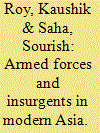

|
|
|
|
|
| Edition |
South Asia ed.
|
| Publication |
Oxon, Routledge, 2016.
|
| Description |
xii, 246p.: mapshbk
|
| Standard Number |
9781138210431
|
|
|
|
|
|
|
|
|
|
|
|
Copies: C:1/I:0,R:0,Q:0
Circulation
| Accession# | Call# | Current Location | Status | Policy | Location |
| 058724 | 355.0218/ROY 058724 | Main | On Shelf | General | |
|
|
|
|
| 2 |
ID:
125187
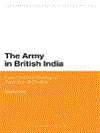

|
|
|
|
|
| Publication |
London, Bloomsbury, 2013.
|
| Description |
xi, 238p.Hbk
|
| Contents |
B
|
| Standard Number |
9781441177308
|
|
|
|
|
|
|
|
|
|
|
|
Copies: C:1/I:0,R:0,Q:0
Circulation
| Accession# | Call# | Current Location | Status | Policy | Location |
| 057525 | 954.03/ROY 057525 | Main | On Shelf | General | |
|
|
|
|
| 3 |
ID:
131294
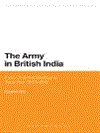

|
|
|
|
|
| Publication |
London, Bloomsbury, 2013.
|
| Description |
xi, 238p.Hbk
|
| Standard Number |
9781441177308
|
|
|
|
|
|
|
|
|
|
|
|
Copies: C:1/I:0,R:0,Q:0
Circulation
| Accession# | Call# | Current Location | Status | Policy | Location |
| 057785 | 954.03/ROY 057785 | Main | On Shelf | General | |
|
|
|
|
| 4 |
ID:
081100
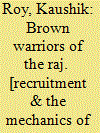

|
|
|
|
|
| Publication |
New Delhi, Manohar Publishers & Distributors, 2008.
|
| Description |
350p.
|
| Standard Number |
8173047545
|
|
|
|
|
|
|
|
|
|
|
|
Copies: C:1/I:0,R:0,Q:0
Circulation
| Accession# | Call# | Current Location | Status | Policy | Location |
| 053213 | 954.03/ROY 053213 | Main | On Shelf | General | |
|
|
|
|
| 5 |
ID:
107732
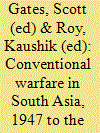

|
|
|
|
|
| Publication |
Surrey, Ashgate Publishing, 2011.
|
| Description |
xxx, 415p.
|
| Series |
Critical essays on warfare in South Asia, 1947 to the present
|
| Standard Number |
9780754629757, hbk
|
|
|
|
|
|
|
|
|
|
|
|
Copies: C:1/I:0,R:0,Q:0
Circulation
| Accession# | Call# | Current Location | Status | Policy | Location |
| 056223 | 355.020954/GAT 056223 | Main | On Shelf | General | |
|
|
|
|
| 6 |
ID:
098855
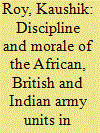

|
|
|
|
|
| Publication |
2010.
|
| Summary/Abstract |
Towards the end of World War II, the morale of British units stationed in Burma and India was on a downslide. In contrast, the morale of Indian units was quite high. In fact, after the 1943 Arakan Campaign, the morale of Indian units rose slowly but steadily. The morale and discipline of Indian troops are also compared and contrasted with another colonial army: the African troops. By making a comparative study of the Commonwealth troops deployed in Burma and India, this paper attempts to show how and why the contours of morale and discipline changed among the various groups of troops at different times. The study of morale and discipline of the troops deployed in these two regions represents two extreme conditions: while Burma remained a war front, India did not experience any actual warfare except for some skirmishes with Indus tribes at the northwest frontier. In general, bad discipline is partly responsible for bad morale and vice versa, which adversely affects the fighting power of armies. This turns to the issue of 'why do men fight'? The 'will to war' is directly proportional to good discipline and strong morale amongst troops. This paper will look for the causative factors shaping discipline and morale of both metropolitan and colonial soldiers, based mainly on military intelligence reports on morale. We will see that rather than grand ideas like nationalism and anti-fascism, mundane factors like the supply of good rations, access to sex and service conditions, influence the morale and discipline of soldiers, and hence their combat-worthiness.
|
|
|
|
|
|
|
|
|
|
|
|
|
|
|
|
| 7 |
ID:
053548
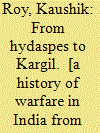

|
|
|
|
|
| Publication |
New Delhi, Manohar Publishers, 2004.
|
| Description |
283p.hbk
|
| Standard Number |
8173045437
|
|
|
|
|
|
|
|
|
|
|
|
Copies: C:1/I:0,R:0,Q:0
Circulation
| Accession# | Call# | Current Location | Status | Policy | Location |
| 048560 | 954.052/ROY 048560 | Main | On Shelf | General | |
|
|
|
|
| 8 |
ID:
054967
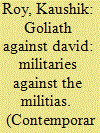

|
|
|
|
|
| Publication |
Jan-Mar 2002.
|
|
|
|
|
|
|
|
|
|
|
|
|
|
|
|
| 9 |
ID:
149141
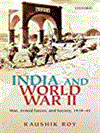

|
|
|
|
|
| Publication |
New Delhi, Oxford University Press, 2016.
|
| Description |
xxi, 401p.: tables, maps, figurehbk
|
| Standard Number |
9780199463534
|
|
|
|
|
|
|
|
|
|
|
|
Copies: C:1/I:0,R:0,Q:0
Circulation
| Accession# | Call# | Current Location | Status | Policy | Location |
| 058899 | 940.54/ROY 058899 | Main | On Shelf | General | |
|
|
|
|
| 10 |
ID:
165005
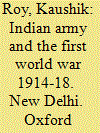

|
|
|
|
|
| Publication |
New Delhi, Oxford University Press, 2018.
|
| Description |
xx, 410p.hbk
|
| Standard Number |
9780199485659
|
|
|
|
|
|
|
|
|
|
|
|
Copies: C:1/I:0,R:0,Q:0
Circulation
| Accession# | Call# | Current Location | Status | Policy | Location |
| 059626 | 940.3/ROY 059626 | Main | On Shelf | General | |
|
|
|
|
| 11 |
ID:
188314
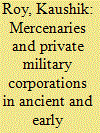

|
|
|
|
|
| Summary/Abstract |
In India, from the time of emergence of empires in circa 300 BCE till the rise of British power in eighteenth century, military mercenaries and private military companies dominated the politico-military landscape. Premodern India had both secular (military guilds) and religious (based on temples and akharas) military corporations. The mercenaries were mostly marginal peasants and demobilised soldiers. They were hired through the agency of their clan leaders, tribal chieftains or the zamindars (large landlords) in whose villages they resided. Historians argue that the presence of the mercenaries and extra state military corporations prevented the rise of strong states in premodern India. In this paper, based mostly on indigenous sources, I argue that the military mercenaries and the private military corporations of pre-British India were at the forefront of technological development. The mercenaries were the channel through which tools, techniques, and ideas of warfare were transferred. The rulers relied on the mercenaries because of their military skills and in the long run they also proved to be cheaper compared to the cost of maintaining permanently a large regular army.
|
|
|
|
|
|
|
|
|
|
|
|
|
|
|
|
| 12 |
ID:
088705
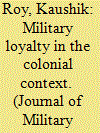

|
|
|
| 13 |
ID:
066162
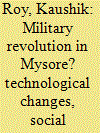

|
|
|
| 14 |
ID:
107731
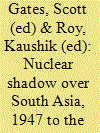

|
|
|
|
|
| Publication |
Surrey, Ashgate Publishing, 2011.
|
| Description |
xxviii,
|
| Series |
Critical essays on warfare in South Asia, 1947 to the present
|
| Standard Number |
9780754629764, hbk
|
|
|
|
|
|
|
|
|
|
|
|
Copies: C:1/I:0,R:0,Q:0
Circulation
| Accession# | Call# | Current Location | Status | Policy | Location |
| 056224 | 355.02170954/GAT 056224 | Main | On Shelf | General | |
|
|
|
|
| 15 |
ID:
088291
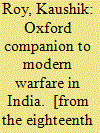

|
|
|
|
|
| Publication |
Oxford, Oxford University Press, 2009.
|
| Description |
xvi, 326p.
|
| Standard Number |
9780195698886
|
|
|
|
|
|
|
|
|
|
|
|
Copies: C:1/I:0,R:1,Q:0
Circulation
| Accession# | Call# | Current Location | Status | Policy | Location |
| 054217 | 355.02180954/ROY 054217 | Main | On Shelf | Reference books | |
|
|
|
|
| 16 |
ID:
130010
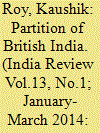

|
|
|
|
|
| Publication |
2014.
|
| Summary/Abstract |
The Partition of the British Indian Empire in the summer of 1947 was a watershed in British-Imperial as well as South Asian history. From the imperial perspective, the British Empire lost much of its luster after the loss of its jewel in the crown. From the perspectives of the inhabitants of the Indian subcontinent, several millions died in the ensuing Partition riots and the mass migrations following the division of British India into two new sovereign countries: India and Pakistan. Today American, British, Indian, Pakistani, and to a lesser extent Bangladeshi scholars continue to debate various aspects of the Partition of India.
|
|
|
|
|
|
|
|
|
|
|
|
|
|
|
|
| 17 |
ID:
121984
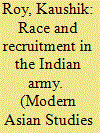

|
|
|
|
|
| Publication |
2013.
|
| Summary/Abstract |
In 1914, the Indian Army was deployed against the enemies of the British Empire. This paper analyses the administrative mechanism as well as the imperial assumptions and attitudes which shaped the recruitment policy of the Indian Army during the First World War. From the late nineteenth century, the Martial Race theory (a bundle of contradictory ideas) shaped the recruitment policy. With certain modifications, this theory remained operational to the first decade of the twentieth century. The construction of the 'martial races' enabled the British to play-off different communities against each other to prevent the emergence of a unified anti-British sentiment among the colonized. During the Great War, faced with the rising demands of manpower, the army was forced to modify the Martial Race theory. However, a conscript army did not emerge in British-India. This was due to imperial policies, the inherent social divisions of Indian society, and because the demands for military manpower remained relatively low in comparison to India's demographic resources. Due to innovations in the theory and praxis of recruitment, the volume of recruitment showed a linear increase from 1914 to 1918, with maximum intensification of recruitment occurring during 1917 and 1918. But as the war ended in November 1918, despite the entry of several new communities, the bulk of the Indian Army still came from the traditional martial races.
|
|
|
|
|
|
|
|
|
|
|
|
|
|
|
|
| 18 |
ID:
188980
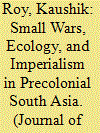

|
|
|
|
|
| Summary/Abstract |
This article uses the concept of “small war” to analyze military confrontations between the Mughal Empire and the Ahom Kingdom of Assam during the seventeenth century. The Mughals launched a series of conventional campaigns on the land and along the rivers. The Ahoms responded with both conventional and guerrilla attacks. For the Mughals, military operations in Assam were limited wars; the Ahom monarchy was a nuisance. However, the Mughal Empire posed an existential threat to the Ahom Kingdom, and the Ahoms fought for their survival. In the Mughal-Ahom confrontations, geography and managerial factors functioned as crucial drivers. Despite technical and firepower superiority, the Mughals were defeated.
|
|
|
|
|
|
|
|
|
|
|
|
|
|
|
|
| 19 |
ID:
107730
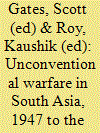

|
|
|
|
|
| Publication |
Surrey, Ashgate Publishing, 2011.
|
| Description |
xxx, 376p.
|
| Series |
Critical essays on warfare in South Asia, 1947 to the present
|
| Standard Number |
9780754629771, hbk
|
|
|
|
|
|
|
|
|
|
|
|
Copies: C:1/I:0,R:0,Q:0
Circulation
| Accession# | Call# | Current Location | Status | Policy | Location |
| 056222 | 355.02180954/GAT 056222 | Main | On Shelf | General | |
|
|
|
|
| 20 |
ID:
104844
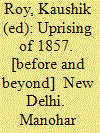

|
|
|
|
|
| Publication |
New Delhi, Manohar Publications, 2010.
|
| Description |
294p.
|
| Standard Number |
9788173048913, hbk
|
|
|
|
|
|
|
|
|
|
|
|
Copies: C:1/I:0,R:0,Q:0
Circulation
| Accession# | Call# | Current Location | Status | Policy | Location |
| 056117 | 954.031/ROY 056117 | Main | On Shelf | General | |
|
|
|
|
|
|
|
|
|